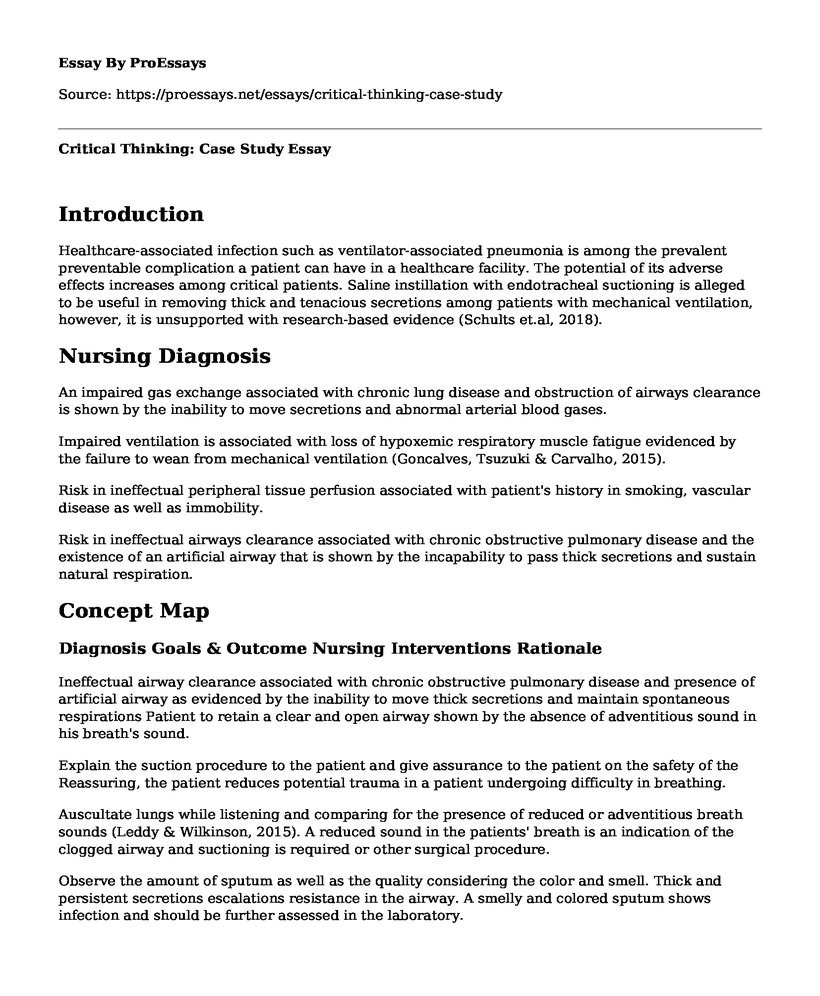Introduction
Healthcare-associated infection such as ventilator-associated pneumonia is among the prevalent preventable complication a patient can have in a healthcare facility. The potential of its adverse effects increases among critical patients. Saline instillation with endotracheal suctioning is alleged to be useful in removing thick and tenacious secretions among patients with mechanical ventilation, however, it is unsupported with research-based evidence (Schults et.al, 2018).
Nursing Diagnosis
An impaired gas exchange associated with chronic lung disease and obstruction of airways clearance is shown by the inability to move secretions and abnormal arterial blood gases.
Impaired ventilation is associated with loss of hypoxemic respiratory muscle fatigue evidenced by the failure to wean from mechanical ventilation (Goncalves, Tsuzuki & Carvalho, 2015).
Risk in ineffectual peripheral tissue perfusion associated with patient's history in smoking, vascular disease as well as immobility.
Risk in ineffectual airways clearance associated with chronic obstructive pulmonary disease and the existence of an artificial airway that is shown by the incapability to pass thick secretions and sustain natural respiration.
Concept Map
Diagnosis Goals & Outcome Nursing Interventions Rationale
Ineffectual airway clearance associated with chronic obstructive pulmonary disease and presence of artificial airway as evidenced by the inability to move thick secretions and maintain spontaneous respirations Patient to retain a clear and open airway shown by the absence of adventitious sound in his breath's sound.
Explain the suction procedure to the patient and give assurance to the patient on the safety of the Reassuring, the patient reduces potential trauma in a patient undergoing difficulty in breathing.
Auscultate lungs while listening and comparing for the presence of reduced or adventitious breath sounds (Leddy & Wilkinson, 2015). A reduced sound in the patients' breath is an indication of the clogged airway and suctioning is required or other surgical procedure.
Observe the amount of sputum as well as the quality considering the color and smell. Thick and persistent secretions escalations resistance in the airway. A smelly and colored sputum shows infection and should be further assessed in the laboratory.
Observe oxygen saturations always, arterial blood gases before and after suctioning using a pulse oximetry Pulse oximetry provides an actual value to assess oxygenation of the patient. Patients that have oxygen circulation problems might change their peripheral saturation levels. Therefore, arterial blood gas provides the best record of oxygenation.
The patient should be observed for peak airway pressures and resistance. The presence of resistance shows inefficient ventilation because of retained secretions.
Give the patient adequate fluids through the IV and nasogastric tube as required. Sufficiently hydrating, the patient decreases the viscosity of secretions that eases suctioning. However, monitoring is critical since the excess fluid in a cardiac surgery patient increases the chances of complications.
Based on the sounds from patient breath, or ventilator pressure, closed line suctioning should be instituted. Increased ventilator pressures and breath sounds may show that secretions are causing airway resistance. Too much suctioning might result in hypoxia and airway tissue injuries. Using in-line suction reduces the rate of infection (Yang & Shin, 2017).
Hyperoxygenate before suctioning and avoid saline instillation before suctioning Hyperoxygenation decreases hypoxia and cardiac dysrhythmias during suctioning. Instilling saline before suctioning has been shown to reduce oxygenation, and a correlation to the development of pneumonia is still unclear. Using humidification or a mucolytic may be a beneficial alternative (Martin, 2017)
Raise the head section of the bed and ensure the patient is turned after every 2 hours. Elevating the head of a patient will assist in reducing the pressure on the diaphragm. Moreover, changing the patient's position assists mobilize secretions and preventing VAP.
References
Goncalves, R. L., Tsuzuki, L. M., & Carvalho, M. G. S. (2015). Endotracheal suctioning in intubated newborns: an integrative literature review. Revista Brasileira de Terapia intensive, 27(3), 284-292. doi: 10.5935/0103-507X.20150048
Leddy, R., & Wilkinson, J. M. (2015). Endotracheal suctioning practices of nurses and respiratory therapists: how well do they align with clinical practice guidelines?. Canadian Journal of respiratory therapy: CJRT= Revue Canadienne de la therapies respiratory: RCTR, 51(3), 60.
Martin, P. (2017). 6 Mechanical Ventilation Nursing Care Plans. Retrieved from: https://nurseslabs.com/6-mechanical-ventilation-nursing-care-plans/2/
Schults, J. A., Cooke, M., Long, D. A., Schibler, A., Ware, R. S., & Mitchell, M. L. (2018). Normal saline instillation versus no normal saline instillation And lung Recruitment versus no lung recruitment with pediatric Endotracheal Suction: the NARES trial. A study protocol for a pilot, factorial randomized controlled trial. BMJ Open, 8(1), e019789. DOI: 10.1046/j.1365-2648.1999.00977.x
Yang, E., & Shin, H. (2017). Adherence to Clinical Guidelines for Endotracheal Suction in ICU Nurses. Journal of East-West Nursing Research, 23(1), 53-62. doi: 10.1155/2009/872921
Cite this page
Critical Thinking: Case Study. (2022, Mar 11). Retrieved from https://proessays.net/essays/critical-thinking-case-study
If you are the original author of this essay and no longer wish to have it published on the ProEssays website, please click below to request its removal:
- President Obama Motivational Speech to Elementary School Children
- Child Welfare and Information and Communication Technology
- Children's Online Privacy Protection Essay Example
- School Engagement Among LGBTQ High School Students Paper Example
- University Attending: My Reasons and Advantages - Essay Sample
- Stomp Rocket Stunt Plane: An Exciting Toy for Kids' Growth and Development - Essay Sample
- Essay Example on My Childhood Experience: Determining My Future







